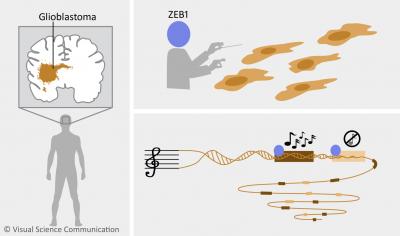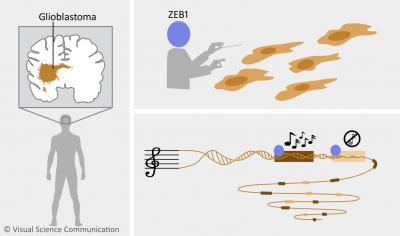
Credit: Visual Science Communication
Glioblastoma is the most severe form of brain cancer in adults. The aggressiveness of this cancer is largely due to its ability to invade surrounding brain tissue, making the tumor difficult to remove by surgery. Now, a research team led by Diogo Castro, from Instituto Gulbenkian de Ciencia (IGC, Portugal), discovered a genetic programme that controls the invasiveness of this form of cancer. This research, published now in The EMBO Journal*, may open avenues for developing new therapies.
Glioblastoma is a tumor that often reappears after surgery. This is in part because its cancer cells easily blend in with normal cells, making it difficult for the surgeon to remove the tumor in its entirety. Moreover, glioblastoma contains "cancer stem cells", which have the capacity to originate a new tumor. If a few of these cells are left behind, a new tumor begins to form.
"The invasiveness of this form of tumor is a serious issue and many researchers are trying to understand the mechanisms that allow glioblastoma cells to invade the surrounding brain tissue", says Diogo Castro. A molecule previously known to be involved in glioblastoma invasiveness is Zeb1. "Zeb1 belongs to an important group of regulatory molecules called transcription factors. These act inside the cell as a conductor does with an orchestra, telling musicians who should be playing, and when. Transcription factors do the same thing with genes", explained Pedro Rosmaninho, first author of this study.
"Our work confirmed the important role Zeb1 has in glioblastoma, by helping us to understand how it operates inside cancer cells when it enables them to invade the healthy brain tissue around the tumor", added the IGC researcher. Using cultures of cells established from human biopsies, and genetic databases constructed from the analysis of hundreds of gliobastoma tumors, the research team mapped which genes within the genome are targeted by Zeb1. Strikingly, researchers observed that Zeb1 orchestrates changes in the properties of cancer cells, by playing a dual role: it is able to simultaneously switch "on" and "off" a vast number of genes. This changes how cancer cells interact with each other, and makes them motile so they can migrate away from the tumor mass.
"The more we know about how glioblastoma tumor cells invade the surrounding tissues, the closer we will be to one day finding effective therapies that disrupt this process", said Diogo Castro.
The estimated prevalence of glioblastoma in the population is one in every 100,000 inhabitants in Europe.
###
This research was conducted at Instituto Gulbenkian de Ciência in collaboration with researchers from the Edinger Institute of Neurology (Germany), and the Montreal Neurological Institute and Hospital at McGill University (Canada). This study was funded by Fundação para a Ciência e a Tecnologia (FCT, Portugal), the Deutsche Forschungsgemeinschaft (Germany), and by the Canadian Institutes of Health Research (Canada).
*Rosmaninho, P., Mükusch S., Piscopo V., Teixeira V., Raposo AASF., Warta, R., Bennewitz, R., Tang, Y., Herold-Mende, C., Stifani, S., Momma, S., Castro, DS. (2018) Zeb1 potentiates genome-wide gene transcription with Lef1 to promote glioblastoma cell invasion. EMBO Journal (http://emboj.embopress.org/cgi/doi/10.15252/embj.201797115)
Media Contact
Ana Mena
[email protected]
351-214-407-959
@IGCiencia
http://www.igc.gulbenkian.pt
Related Journal Article
http://dx.doi.org/10.15252/embj.201797115





